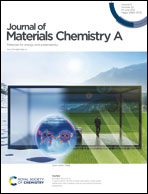Dual modulation of lattice strain and charge polarization induced by Co(OH)2/Ni(OH)2 interfaces for efficient oxygen evolution catalysis†
Abstract
Two-dimensional transition metal hydroxides are greatly limited in the application of the electrocatalytic oxygen evolution reaction (OER) due to its large and inert basal planes. Herein, we report a one-step in situ etching hydrothermal method to construct Co(OH)2 and Ni(OH)2 heterostructure nanomaterials, successfully activating the basal plane of Co(OH)2. The abundant lattice strains that appear at heterogeneous interfaces cause a downshift of the d-band center of Co in Co(OH)2 and promote the desorption of oxygen during the OER process, which accelerates reaction kinetics of the OER and improves catalytic activity effectively. Furthermore, the electron interaction at the Co(OH)2/Ni(OH)2 interfaces leads to charge polarization, which will regulate the adsorption and dissociation of H2O molecules and enhances mass and electron transfer. Owing to the above advantages of Co(OH)2/Ni(OH)2 interfaces, the as-prepared composite catalysts show an excellent OER catalytic performance with a low overpotential of only about 270 mV at 20 mA cm−2, maintaining long-term catalytic stability for more than 24 h at 20 mA cm−2.



 Please wait while we load your content...
Please wait while we load your content...